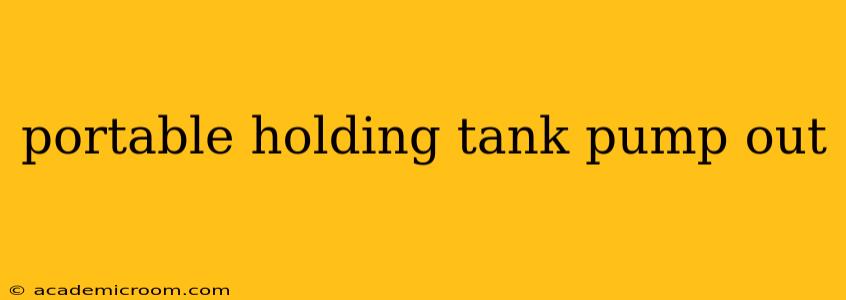Dealing with a portable holding tank, whether for an RV, boat, or other application, requires a reliable and efficient pump-out system. This guide explores the world of portable holding tank pump-outs, addressing common questions and providing valuable insights into choosing the right equipment and ensuring proper sanitation.
What is a portable holding tank pump out system?
A portable holding tank pump-out system is a self-contained unit designed to empty waste from a portable holding tank. Unlike permanently installed systems, these are mobile and easily transported to different locations. They typically consist of a pump, hoses, and a waste receptacle or connection to a sewer system. The pump creates suction to remove the waste, and hoses transfer it to a designated disposal point. The systems vary in size and capacity, catering to different tank sizes and waste volumes.
What are the different types of portable holding tank pump out systems?
Several types of portable holding tank pump-out systems exist, each with its own advantages and disadvantages:
-
Manual Pumps: These are hand-powered pumps, generally the most affordable option. However, they require significant physical effort and are best suited for smaller tanks.
-
Electric Pumps: These use electricity to power the pump, making the process much easier and faster. They're ideal for larger tanks and offer greater convenience. These can be 12V (for RV use) or 120V (household electricity).
-
Diaphragm Pumps: These pumps utilize a flexible diaphragm to create suction and pressure, making them suitable for thicker liquids and more resistant to clogging.
-
Centrifugal Pumps: These are generally higher-capacity pumps, suitable for faster emptying of larger tanks.
How much does a portable holding tank pump out system cost?
The cost varies widely depending on the type, capacity, and features. Manual pumps can cost a few hundred dollars, while electric pumps can range from several hundred to over a thousand dollars. Factors such as hose length, material quality, and additional features (like built-in filters) also impact the overall price.
How do I choose the right portable holding tank pump out system?
Choosing the right system depends on several factors:
-
Tank Size: The capacity of your holding tank dictates the pump's required flow rate and power.
-
Waste Type: If dealing with particularly thick or viscous waste, a diaphragm pump might be more suitable.
-
Power Source: Consider the availability of electricity (12V or 120V) or if you prefer the manual option.
-
Budget: Set a realistic budget before starting your search.
-
Portability: Think about how easy the unit needs to be to transport and store.
Where can I dispose of the waste from my portable holding tank?
Proper waste disposal is crucial. Options include:
-
RV Parks and Campgrounds: Many RV parks and campgrounds have designated dump stations.
-
Marinas and Boat Ramps: Marinas typically provide pump-out services for boats.
-
Sewage Treatment Plants: Some areas allow disposal at sewage treatment plants, but you must check local regulations.
-
Septic Tank Services: Septic tank pumping services can also handle waste from portable holding tanks, though this is often the most expensive option.
What are the best practices for using a portable holding tank pump out system?
-
Follow Manufacturer's Instructions: Always refer to the manufacturer's instructions for proper use and maintenance.
-
Wear Protective Gear: Use gloves and eye protection when handling waste.
-
Proper Disposal: Ensure you dispose of the waste responsibly and according to local regulations.
-
Regular Maintenance: Clean and maintain the system regularly to prevent clogging and malfunctions.
By understanding the different types of portable holding tank pump-out systems and following best practices, you can ensure efficient and sanitary waste removal, contributing to a cleaner and healthier environment. Remember to always prioritize responsible waste disposal methods.
